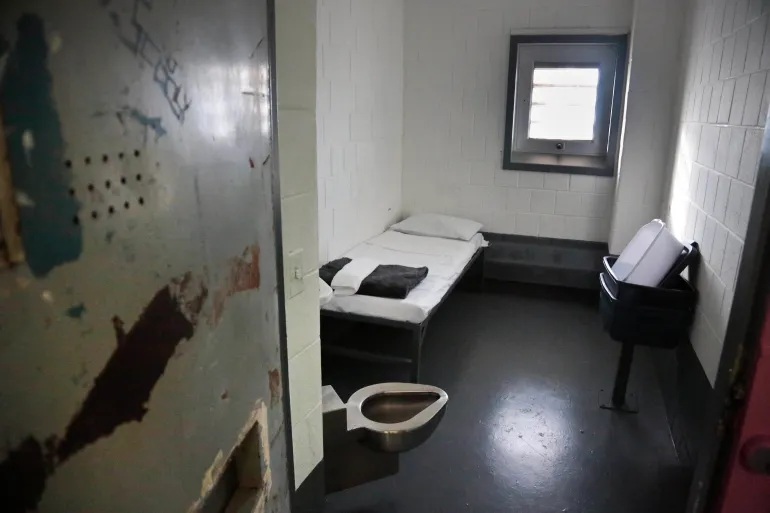Terry A Kupers
As a forensic psychiatrist, I have studied and testified in court for over four decades about the harms of solitary confinement. Research indicates it does not reduce violence behind bars, and in US states where the population in solitary confinement has been reduced, the result has actually been a reduction in the rate of prison violence.
The harm stems from social isolation and forced idleness. Human beings are social creatures who need human engagement and meaningful productive activities to sustain mental stability, healthy relationships and productive pro-social pursuits. Forced isolation leads to a decimation of life skills, including the capacity to resolve differences peacefully, and that explains why there is less violence in the prisons when the use of solitary confinement declines. The well-known psychological effects of being alone in a cell nearly 24 hours per day with no meaningful activities include severe anxiety, panic, paranoia, problems with memory and concentration that make reading and studying nearly impossible, despair, depression, self-mutilation, the exacerbation of mental illness and an extraordinarily high rate of suicide. Solitary confinement also worsens medical conditions such as heart disease, hypertension and diabetes. It’s no surprise that individuals who have spent significant time in solitary are at a much-heightened risk of substance abuse and crime, subsequent to their release from prison. They also have an increased mortality rate from all causes in the year following their release. Solitary confinement is disproportionately inflicted on Black, Latino, Native American and other people of colour. The United Nations Special Rapporteur on Torture declared solitary confinement for more than 15 days to be torture, and the United Nations Standard Minimum Rules for the Treatment of Prisoners (the Mandela Rules) prohibit more than 15 days of solitary confinement.
Yet, in the US, more than 120,000 prisoners are consigned to solitary confinement, many for years and even decades. Dennis Wayne Hope spent 27 years in solitary confinement in the Texas Department of Criminal Justice. The Box: 27 Years in Solitary Confinement, a recent 30-minute documentary on Al Jazeera Fault Lines tells his story. Hope speaks frankly on camera about the devastating effects of solitary confinement, including an impulse to self-harm, massive despair and frighteningly altered thoughts and perceptions. It is notable that he was convicted for non-violent robberies, so he is hardly “the worst of the worst,” the label prison authorities use to stigmatise individuals they put in solitary confinement. He escaped prison twice in the 1990s, resulting in his being sent to solitary confinement for 27 years. His journey is remarkable in the ways he figured out how to maintain his emotional stability as well as his quest for freedom under extraordinarily harsh conditions. This must-see documentary provides rich and inspiring lessons in resilience as well as ingenuity in devising ways to remain sane in a psychosis-inducing torture-chamber. Hope exhibited remarkable emotional stability against all odds while in “The Box” for 27 years. But individuals who suffer from serious mental illness are condemned to experience even worse mental illness in solitary confinement. Still, in many departments of correction, people with serious mental illness are selectively consigned to solitary confinement and left there for years, usually in the context of very substandard correctional mental health services. An explosive growth in the number of prisoners with serious mental illness occurred subsequent to de-institutionalisation and the incremental defunding of public mental health services.
The neoliberal agenda since the mid-1970s has been to dismantle social welfare safety net programmes, including public mental health, vocational support and affordable housing. As a result, the population in psychiatric hospitals has dramatically shrunk while the number of people with serious mental illness in jail and prison has grown geometrically. There are currently far more people with serious mental illness in jails and prisons than there are in psychiatric hospitals. It is as if the people whose needs are ignored on account of cruel social priorities are disappeared into jails and prisons so more affluent people will not have to see them unhoused and floundering on the streets. Then, once behind bars, they are disappeared again, into solitary confinement where, out of public view, their mental illness is exacerbated or they die by suicide. There is a growing momentum across the United States to restrict or eliminate solitary confinement in jails, prisons and immigration detention facilities. New York State, New Jersey, Colorado and Nevada have enacted laws to end long-term solitary confinement in their prisons. Chicago, New York City, Pennsylvania’s Allegheny County and the State of Colorado have announced an end to solitary confinement in their jails. In California, the Mandela Act, a bill that would restrict solitary confinement in prison and jail to 15 days in accordance with the UN’s Mandela Rules and the standards of the US National Commission on Correctional Health Care, has been passed in both houses of the legislature only to be vetoed by Governor Gavin.
Unsurprisingly, I’ve found that in facility after facility that offers this kind of “alternative,” prisoners reject it, choosing to remain in their cells rather than spend hours in a separate cage with nothing to do and nowhere to sit, and these cage-like structures remain mostly empty. The alternatives to solitary confinement must include meaningful programmes that educate and rehabilitate individuals who land in prison. We know how to run such rehabilitation programmes. We as a society simply lack the will to treat folks in prison with respect and compassion. Given all the momentum and public support for restricting and eventually eliminating solitary confinement, we have a real opportunity to actually eliminate the practice and replace it with evidence-based alternatives that foster mental health and rehabilitation and make possible eventual successful reintegration into the community. For the sake of public safety, as well as our humanity and morality, our local, state and federal governments need to embrace a true end to solitary confinement in all its forms and by all its names.







